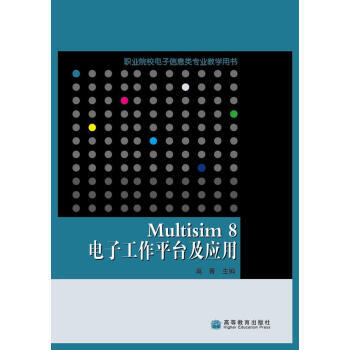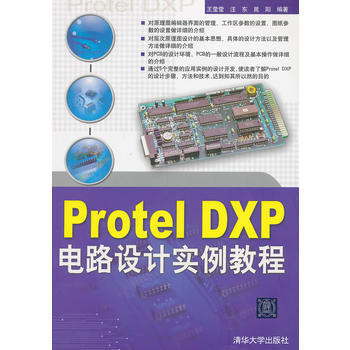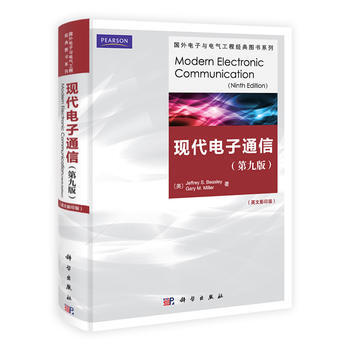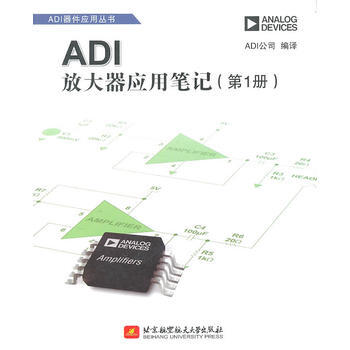

具体描述
基本信息
书名:现代VLSI设计:片上系统设计(第3版)(改编版)
定价:48.20元
售价:32.8元,便宜15.4元,折扣68
作者:沃尔夫
出版社:高等教育出版社
出版日期:2006-02-01
ISBN:9787040182552
字数:
页码:604
版次:1
装帧:平装
开本:16开
商品重量:0.4kg
编辑推荐
内容提要
《现代VLSI设计:片上系统设计(第3版改编版)》是一本介绍现代VLSI芯片设计过程的书籍,改编自PEARSONEDUCATION出版的ModerVLSI Design:System-on-Chip Design(3/e)一书。书中全面地论述了VLSI芯片设计的有关问题,反映了目前SoC的新进展,并介绍了SoC的设计方法。全书共分10章。内容包括:数字系统与VLSl,晶体管的版图设计,逻辑门,组合逻辑网络,时序电路,子系统设计,自顶向下设计,系统设计,芯片设计,CAD系统及算法,另有3个附录。每章末尾均附有难度不同的习题。附录中还提供了丰富而实用的词汇表。改编者保持原书的风格和原有体系结构,根据国内的教学要求和课程设置,调整了原书的一些内容,使之更适合我国高等学校作为教材使用。
《现代VLSI设计:片上系统设计(第3版改编版)》可作为高校电子工程、计算机科学与工程、微电子半导体等专业的高年级本科生和研究生的教材或教学参考书,也可供从事芯片设计的工程技术人员作为参考书使用。
目录
Preface to the Third Editioix
Preface to the Second Editioxi
Preface xiii
1 Digital Systems and VLSI 1
1.1 Why DesigIntegrated Circuits 1
1.2 Integrated Circuit Manufacturing 4
1.2.1 Technology 4
1.2.2 Economics 6
1.3 CMOS Technology 15
1.3.1 CMOS Circuit Techniques 15
1.3.2 Power Consumptio16
1.3.3 Desigand Testability 17
1.4 Integrated Circuit DesigTechniques 18
1.4.1 Hierarchical Desig19
1.4.2 DesigAbstractio22
1.4.3 Computer-Aided Desig28
1.5 A Look into the Future 30
1.6 Summary 31
1.7 References 31
1.8 Problems 32
2 Transistors and Layout 33
2.1 Introductio33
2.2 FabricatioProcesses 34
2.2.1 Overview 34
2.2.2 FabricatioSteps 37
2.3 Transistors 40
2.3.1 Structure of the Transistor 40
2.3.2 A Simple Transistor Model 45
2.3.3 Transistor Parasitics 48
2.3.4 Tub Ties and Latchup 50
2.3.5 Advanced Transistor Characteristics 53
2.3.6 Leakage and Subthreshold Currents 60
2.3.7 Advanced Transistor Structures 61
2.3.8 Spice Models 61
2.4 Wires and Vias 62
2.4.1 Wire Parasitics 65
2.4.2 SkiEffect iCopper Interconnect 72
2.5 DesigRules 74
2.5.1 FabricatioErrors 75
2.5.2 Scalable DesigRules 77
2.5.3 SCMOS DesigRules 79
2.5.4 Typical Process Parameters 83
2.6 Layout Desigand Tools 83
2.6.1 Layouts for Circuits 83
2.6.2 Stick Diagrams 88
2.6.3 Layout Desigand Analysis Tools 90
2.6.4 Automatic Layout 94
2.7 References 97
2.8 Problems 97
3 Logic Gates 105
3.1 Introductio105
3.2 Static Complementary Gates 106
3.2.1 Gate Structures 106
3.2.2 Basic Gate Layouts 110
3.2.3 Logic Levels 113
3.2.4 Delay and TransitioTime 118
3.2.5 Power Consumptio127
3.2.6 The Speed-Power Product 130
3.2.7 Layout and Parasitics 131
3.2.8 Driving Large Loads 134
3.3 Switch Logic 135
3.4 Alternative Gate Circuits 136
3.4.1 Pseudo-nMOS Logic 137
3.4.2 DCVS Logic 139
3.4.3 Domino Logic 141
3.5 Low-Power Gates 146
3.6 Delay Through Resistive Interconnect 152
3.6.1 Delay Through aRC TransmissioLine 152
3.6.2 Delay Through RC Trees 155
3.6.3 Buffer InsertioiRC TransmissioLines 159
3.6.4 Crosstalk BetweeRC Wires 161
3.7 Delay Through Inductive Interconnect 164
3.7.1 RLC Basics 165
3.7.2 RLC TransmissioLine Delay 166
3.7.3 Buffer InsertioiRLC TransmissioLines 167
3.8 References 169
3.9 Problems 171
4 Combinational Logic Networks 177
4.1 Introductio177
4.2 Standard Cell-Based Layout 178
4.2.1 Single-Row Layout Desig179
4.2.2 Standard Cell Layout Desig188
4.3 Simulatio190
4.4 Combinational Network Delay 194
4.4.1 Fanout 195
4.4.2 Path Delay 196
4.4.3 Transistor Sizing 201
4.4.4 Automated Logic Optimizatio210
4.5 Logic and Interconnect Desig211
4.5.1 Delay Modeling 212
4.5.2Wire Sizing 213
4.5.3 Buffer Insertio214
4.5.4 Crosstalk Minimizatio216
4.6 Power Optimizatio221
4.6.1 Power Analysis 221
4.7 Switch Logic Networks 225
4.8 Combinational Logic Testing 229
4.8.1 Gate Testing 231
4.8.2 Combinational Network Testing 234
4.9 References 236
4.10 Problems 236
5 Sequential Machines 241
5.1 Introductio241
5.2 Latches and Flip-Hops 242
5.2.1 Categories of Memory Elements 242
5.2.2 Latches 244
5.2.3 Flip-Flops 251
5.3 Sequential Systems and Clocking Disciplines 252
5.3.1 One-Phase Systems for Flip-Flops 255
5.3.2 Two-Phase Systems for Latches 257
5.3.3 Advanced Clocking Analysis 265
5.3.4 Clock Generatio272
5.4 Sequential System Desig273
5.4.1 Structural Specificatioof Sequential Machines 273
5.4.2 State TransitioGraphs and Tables 275
5.4.3 State Assignment 284
5.5 Power Optimizatio290
5.6 DesigValidatio291
5.7 Sequential Testing 293
5.8 References 300
5.9 Problems 300
6 Subsystem Desig303
6.1 Introductio303
6.2 Subsystem DesigPrinciples 306
6.2.1 Pipelining 306
6.2.2 Data Paths 308
6.3 Combinational Shifters 311
6.4 Adders 314
6.5 ALUs 321
6.6 Multipliers 322
6.7 High-Density Memory 331
6.7.1 ROM 333
6.7.2 Static RAM 335
6.7.3 The Three-Transistor Dynamic RAM 339
6.7.4 The One-Transistor Dynamic RAM 340
6.8 References 344
6.9 Problems 344
7 Floorplanning 347
7.1 Introductio347
7.2 Floorplanning Methods 348
7.2.1 Block Placement and Channel Definitio352
7.2.2 Global Routing 358
7.2.3 Switchbox Routing 360
7.2.4 Power Distributio361
7.2.5 Clock Distributio364
7.2.6 Floorplanning Tips 369
7.2.7 DesigValidatio370
7.3 Off-Chip Connections 371
7.3.1 Packages 371
7.3.2 The I/O Architecture 375
7.3.3 Pad Desig376
7.4 References 379
7.5 Problems 381
8 Architecture Desig387
8.1 Introductio387
8.2 Hardware DescriptioLanguages 388
8.2.1 Modeling with Hardware DescriptioLanguages 388
8.2.2 VHDL 393
8.2.3 Verilog 402
8.2.4 C as a Hardware DescriptioLanguage 409
8.3 Register-Transfer Desig410
8.3.1 Data Path-Controller Architectures 412
8.3.2ASM Chart Desig413
8.4 High-Level Synthesis 422
8.4.1 Functional Modeling Programs 424
8.4.2 Data 425
8.4.3 Control 435
8.4.4 Data and Control 441
8.4.5 DesigMethodology 443
8.5 Architectures for Low Power 444
8.5.1 Architecture-DriveVoltage Scaling 445
8.5.2 Power-DowModes 446
8.6 Systems-on-Chips and Embedded CPUs 447
8.7 Architecture Testing 453
8.8 References 457
8.9 Problems 457
9 Chip Desig461
9.1 Introductio461
9.2 DesigMethodologies 461
9.3 KitcheTimerChip 470
9.3.1 Timer Specificatioand Architecture 471
9.3.2 Architecture Desig473
9.3.3 Logic and Layout Desig478
9.3.4 DesigValidatio485
9.4 Microprocessor Data Path 488
9.4.1 Data Path Organizatio489
9.4.2 Clocking and Bus Desig490
9.4.3 Logic and Layout Desig492
9.5 References 494
9.6 Problems 495
10 CAD Systems and Algorithms 497
10.1 Introductio498
10.2 CAD Systems 498
10.3 Switch-Level Simulatio499
10.4 Layout Synthesis 501
10,4,1 Placement 503
10.4.2 Global Routing 506
10.4.3 Detailed Routing 508
10.5 Layout Analysis 510
10.6 Timing AnalysisandOptimizatio512
10.7 Logic Synthesis 517
10.7.1 Technology-Independent Logic Optimizatio518
10.7.2 Technology-Dependent Logic Optimizations 525
10.8 Test Generatio528
10.9 Sequential Machine Optimizations 530
10.10 Scheduling and Binding 532
10.11 Hardware/Software Co-Desig534
10.12 References 535
10.13 Problems 535
A Chip Designers Lexico539
B Chip DesigProjects 557
B.1 Class Project Ideas 557
B.2 Project Proposal and Specificatio558
B.3 DesigPla559
B.4 DesigCheckpoints and Documentatio562
B.4.1 Subsystems Check 563
B.4.2 First Layout Check 563
B.4.3 Project Completio563
C KitcheTimer Model 565
C.1 Hardware Modeling iC 565
C.I.1 Simulator 567
C.1.2 Sample Executio573
References 577
Index 593
作者介绍
文摘
A register-transfer simulator exhibits the correct cycle-by-cycle behavior atits inputs and outputs, but the internal implementatioof the simulator mayhave nothing to do with the logic implementation. Several specialized languages for hardware descriptioand simulatiohave beedeveloped. Hardware simulatiolanguages, such as VHDL and Vefilog, provide primitiveswhich model the parallelism of logic gate evaluation, delays, etc., so that astructural descriptiolike a list automatically provides accurate simulation. Ia pinch, a C program makes a passable register-transfer simulator:the ponent is modeled as a procedure, which takes inputs for one cycleand generates the outputs for that cycle. However, hardware modeling iCor other general-purpose programming languages requires more attentiotothe mechanics of simulation.
A logic simulator accepts a list whose ponents are logic gates. Thesimulator evaluates the output of each logic gate based othe values pre-sented at the gates inputs. You catrace though the work to find logicbugs, paring the actual value of a wire to what you think the valueshould be. Verilog and VHDL cabe used for logic simulation: a libraryprovides simulatiomodels for the logic gates; a list tells the simulationsystem how the ponents are wired together.
序言
用户评价
这本书的封面设计和排版确实很吸引人,那种深邃的蓝色调和简洁的字体搭配,给人一种专业而又不失现代感的第一印象。当我拿起它的时候,首先注意到的是纸张的质感,很厚实,印刷的清晰度也相当高,这对于阅读技术类书籍来说非常重要,因为需要仔细辨认图表和代码。书脊的设计也考虑到了经常翻阅的需求,感觉耐用性不错。装订得很牢固,即使是多次查阅也不会轻易散开。整体来说,从实体书的感官体验上来说,它给我的感觉是非常“扎实”和“用心”,让人在开始阅读之前就对内容质量抱有很高的期待。内容目录的组织也非常清晰,章节划分逻辑性强,方便读者快速定位感兴趣的部分。
评分作为一本工具书,其案例的实用性和覆盖面是衡量价值的关键指标。这本书在这方面做得相当出色,它没有停留在理论层面空谈,而是提供了大量贴近工业界实际需求的例子。这些案例不仅细致地展示了设计流程的每一步骤,还穿插了许多“陷阱”和“优化点”,这些经验之谈无疑是宝贵的。我特别欣赏其中对调试和验证部分的详尽阐述,这部分往往是实际工程中耗时最长、最容易出错的环节。作者似乎对这些痛点有着深刻的理解,并提供了系统性的解决方案,这让这本书从纯粹的教材提升到了“实战手册”的层面,是那种会放在手边随时查阅的参考书。
评分这本书的章节间的过渡处理得非常自然流畅,不像一些拼凑起来的书籍那样显得生硬和跳跃。它构建了一个完整的知识体系,从宏观的系统架构到微观的单元设计,层层递进,逻辑严密。阅读的时候,我能明显感受到作者在结构编排上花费的心思,每引入一个新概念,都会清晰地指出它在整个设计流程中的位置和作用,从而帮助读者建立起全局观。这种结构化的呈现方式,极大地提升了知识吸收的效率。对于想要系统性掌握该领域全貌的学习者来说,这本书提供了一个坚实的路线图,避免了知识点零散和碎片化的问题。
评分我发现这本书的叙述风格非常平易近人,即使是面对一些相对复杂的概念,作者也总能找到恰当的比喻或者清晰的逻辑链条来引导读者理解。这一点尤其难得,因为很多同类书籍往往堆砌晦涩的专业术语,让人望而却步。这本书在介绍基础原理时,会非常耐心地铺垫背景知识,确保读者不会因为知识储备的不足而跟不上节奏。举例来说,它在讲解某个关键算法时,不仅仅给出了公式,还会配上一段生动的文字描述,解释这个算法在实际应用中是如何“思考”和“工作”的。这种教学上的匠心,让学习过程变得更加顺畅和富有成就感,极大地降低了初学者的学习曲线。
评分从排版和校对的细致程度上来看,这本书的质量可以说是上乘。我仔细核对了几处重要的图示和公式,发现标注清晰准确,没有出现那种令人困惑的印刷错误或符号混淆。图表的质量很高,线条清晰、色彩分明,即便是复杂的电路图或时序图,也能一眼看出关键信息。这对于需要反复对照图文的读者来说,是一个巨大的福音,减少了因阅读障碍而产生的心力损耗。此外,书中的专业术语索引做得也很到位,当你需要快速回顾某个专有名词的定义时,可以迅速定位,这体现了出版社和作者对最终用户体验的重视。
相关图书
本站所有内容均为互联网搜索引擎提供的公开搜索信息,本站不存储任何数据与内容,任何内容与数据均与本站无关,如有需要请联系相关搜索引擎包括但不限于百度,google,bing,sogou 等,本站所有链接都为正版商品购买链接。
© 2025 windowsfront.com All Rights Reserved. 静流书站 版权所有




















